 |
|
Introduction | Artworks | Interviews | Bibliography |
| |
 |
FRAGMENTED FIGURE
Account of the Scholarly Exhibition at the Centre of Ceramic Studies, Cardiff
|
 |
| |
Interview Methodology |
Interviews conducted with each contributing artists, provided the researchers with the opportunity to explore a number of key aspects of their practice; the particular ways they engage with the figure in ceramics and develop and articulate their ideas through their artwork. By focussing upon notions of fragmentation, albeit not necessarily the principal subject of the artist’s work, a common theme could be examined in some depth from a variety of perspectives, and achieve a breadth of interpretation without becoming lost in a more general discussion of the figure in art.
Major attention was given to developing an effective structure for the interviews, drawing heavily upon the experience of members of the curatorial team who prior to the project, had developed a range of methods more relevant to the documenting and analysing of artists practice. Interviewing the artists in their studios was crucially important, creating a more comfortable environment and enabling them to make direct reference to examples of their creative work when responding to the questions posed. Questions were also framed in a ways designed to track the artists’ developmental process, to identify key factors, which may influence or impact upon the individual’s practice; and where possible, situate their ideas and practice in a wider context. This enabled a differing of emphasis for each artist dependent on which area most benefited from discussion, for example, in Martini’s work, the process of construction is significant in our understanding of the body exposed to a harsh industrial environment, and in Claire Curneen’s work, the development of ideas more significant in understanding the move from fragile porcelain figures to the martyred St Sebastian. Care was taken to use the same “open questions” with all artists, in the same sequence, providing consistency in the documentation and allowing opportunity for comparison. All participating artists received the list of question in advance of the interview.
As was expected there was significant differences in the ways the artists performed. Few had been formally interviewed before or were less used to discussing the essence of their artistic subject (a more common route in ceramics, is to record biographical, historical or technical accounts of artists’ practice). Nevertheless, all of the artists were able to speak about the process and development of ideas, although some without reference to notions of fragmentation. A fuller evaluation of the interviewing method will be posted on the website at a later date. In the meantime, it is sufficient to report here that the interviews have generated such new insights and understandings of key significance, that a further round of interviews with the same artists are planned.
|
 |
The following clips are intended to be accessible on as wide a range of computers as possible. As a result, clips are kept to approx. 2 minutes. They are designed to download quickly rather than appear at high resolution. A fuller edited version is accessible by contacting: fragmentedfigure@uwic.ac.uk
Interview samples Claire Curneen
Jill Bryars
Natasha Mayo
Frances Woodley
Babette Martini
Christie Brown
Sabine Heller |

 |
Claire Curneen
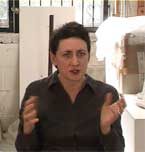
Interview on April 2005
File sizes:
Small MP4 movie 7.1MB
Large MP4 movie 15.2MB
|
|
In this extract, Claire Curneen describes the underlying
subject of her ceramic figures, their evolving themes and
influences, which are inextricably linked to notions of
fragmentation. She continues to explain the process by which she
develops her work, from sketchbooks to consideration of
construction methods and ceramic materials and their relation to this subject matter.
With the figurative work, the works in the studio, some of the works with the trees, they move on from that signature piece of the white standing figure which is something I suppose I’m more known for in 97/98, and there still very much about a similar thing, about the same thing, they have a vulnerability, their about a fragile nature but they are less autobiographical, they are less about me so much! I think that through working with the figure and the referencing material which has arisen over 99/2000 which is specific of the Pierro della Francesca and the Serano images, is the nature of the subject matter and that connection to what is happening, what event is being portrayed, which at the same time has very much a universal language, a universal nature. But in terms of the content of what I’m exploring, things like the St Sebastian figure, which is a figure which is quite well known, I use that to play with ideas of the body, about the flesh as opposed to just the skin of it, how the arrow hits the surface and the time involved in terms of how the gold trickles down the surface, it relates to a time element when the arrow hits. I’m just very drawn to the narrative and the story so I use that as a way to translate ideas about the human condition, about life/death, about connections to our questions on mortality, and issues that are too much to deal with sometimes, but I have this urge to be drawn to them |
| |
|
|
 |
| |
|
|
Jill Bryars
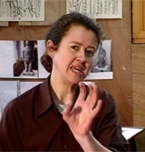
Interview on
March 2005
File sizes:
Small MP4 movie 4.01MB
Large MP4 movie 9.97MB |
|
Jill Bryers here interprets the notion of fragmentation in relation
to her practice. In the interview, she continues to describe her
ceramic figures and in particular, their sense of an emerging form
influenced by children’s drawings, illustrations, their simplicity
and anthropomorphic properties.
The fragmentation of the figure in how I interpret this is more to
do with what is missing and there is certain crudeness to making a
figure perfect and actually rendering and producing and presenting
a complete figure, which would be too obvious and it would be
lacking in anything meaningful to me. Though having said that,
there is something quite neat and tidy and nice and straight forward
and something that appeals to me when I can actually represent
and produce and make a part of the figure or represent the head or
arm and that to me is very pleasing but to actually put them
together to make something perfect is just slightly pointless. This
probably makes is sound faintly ridiculous in describing that
because I’m doing it but putting too much information for the
viewer or representing it too fully is not the point, I'm more
interested in what is missing. And also there are things that you
can do that are more powerful, and more interesting for me. I don’t
want to just make the figure and there it is, I what to show, to
express a little more. |
| |
|
|
 |
| |
|
|
Natasha Mayo

Interview on May 2005
File sizes:
Small MP4 movie 4.74MB
Large MP4 movie 10.73MB |
|
In this extract, Mayo describes her consideration of skin as being innately fragmented. She continues to describe the ways in which she has articulated these ideas in ceramic, in particular, the relationship between two and three dimensions and how illusion of depth rendered onto a figurative form impacts upon our experience of flesh and skin.
I think the notion of fragmentation is a concern for me as a practitioner in two different ways. Firstly, my consideration of skin is not as a wholly encompassing, impermeable layer of the body but rather a membrane through which we emit and are exposed to the environment and absorb. Its fragmented in the sense that the surface of our body is a relationship between the inside and the outside rather than one whole separated thing against another, its more of a dialectic between those two things. And I think that is a significant part of fragmentation, this negotiation between whole and part, its not often black and white but a dialogue, a relationship between those two things. The second element is perception, the means by which we perceive certain qualities. My interest lies in the expression of flesh and skin, in order to evoke the very particular qualities of flesh, I need to exaggerate them, amplify them on the body in such a way that the succession of stages by which we might ordinarily experience the body flushing, the body stretching, shivering is frozen, so its focussing on that particular sensation and no other. So there is a fragmentation in the process by which we experience these works. |
| |
|
|
 |
| |
|
|
Frances Woodley
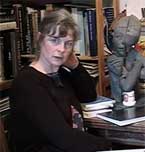
Interview on
Feb 2005
File sizes:
Small MP4 movie 4.01MB
Large MP4 movie 9.97MB |
|
As the interview continues, using examples of her ceramics as
illustration, Woodley further describes ways in which she has
negotiated aspects of the human form and a sense of the ‘other’,
from the unconscious mind to the traversing of realities. Footage
includes explanation of how she has been interested in, and
influenced by, Northern European painting, Surrealism and, most
recently, passages in Rosalind Krauss’ ‘Bachelors’.
…so it was already truncated. To then cut it up, you start to make
fragments but the re-composing of those fragments then started to
work so that this side was of this world; it is vertical and so
therefore it becomes assertive, and this part looks away and then
maybe, I didn’t realize this at the time but I am beginning to realize
it now, that this may subscribe more to the sense of the abject or at
least not of this world, or the other. So maybe the portrait, the self
and the other comes out of this one. But this is very much an
exercise, its not producing a piece of work for an exhibition, this is
in a sense investigating and resolving ideas.  |
| |
|
|
 |
| |
|
|
Babette Martini
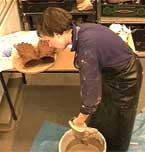
Interview on
March 2005
File sizes:
Small MP4 movie 5.15MB
Large MP4 movie 11.13MB |
|
This extract follows Babette Martini’s explanation of the wider
context and specific concerns of her practice. It is taken from
footage recording her particular process of construction
accompanied by her description of its significance to the
expression of the work.
…these are different hands I made earlier. The hands need to dry
another night so I can dip them into the plaster clay mix that I’m
mixing right now. Its white casting slip I use with pottery plaster
and I also add this time 10% syenite to alter the consistency of the
coating and all this needs to be well mixed. I hold onto the little
handle inside of the hand and dip it into the plaster and after the
emersion it needs to be rested. Here, these are nails hammered to a
board and they have little clay balls on top, if I would rest the hand
immediately on top of the table surface it would stick to it and it
would be very difficult to remove. The hands are immersed several
times into the plaster clay mix but not all have the same amount of
layering, the more I immerse the hand into the plaster the more it
will loose its definition and also the nails leave a different impact
and contribute to the expression of the hand.
In contrast with the other footage the clips of Sabine Heller
and Christie Brown do not include interviews. Their significance
lies in documenting the ways in which evidence of the process of
construction left behind on the surface of the figure can be
considered as contributing to its expressive value, specifically to
notions of fragmentation. |
| |
|
|
 |
| |
|
|
Christie Brown
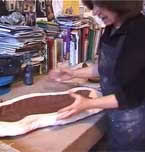
Footage taken 2003
File sizes:
Small MP4 movie 2.03MB
Large MP4 movie 5.87MB |
|
This footage documents Christie brown in her studio constructing the piece Ex Voto-Insignificance 2003. 
|
| |
|
|
 |
| |
|
|
Sabine Heller
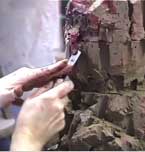
Footage taken 2004
File sizes:
Small MP4 movie 1.69MB
Large MP4 movie 4.60MB |
|
This footage documents Sabine Heller in her studio. 
|
| |
|
|
 |
 |
| University of Wales Intitute, cardiff | Adorfa Prifysgol Cymru, Caerdydd |
 |
 |
 |
 |
 |
 |
 |
 |
 |
 |
 |
|







